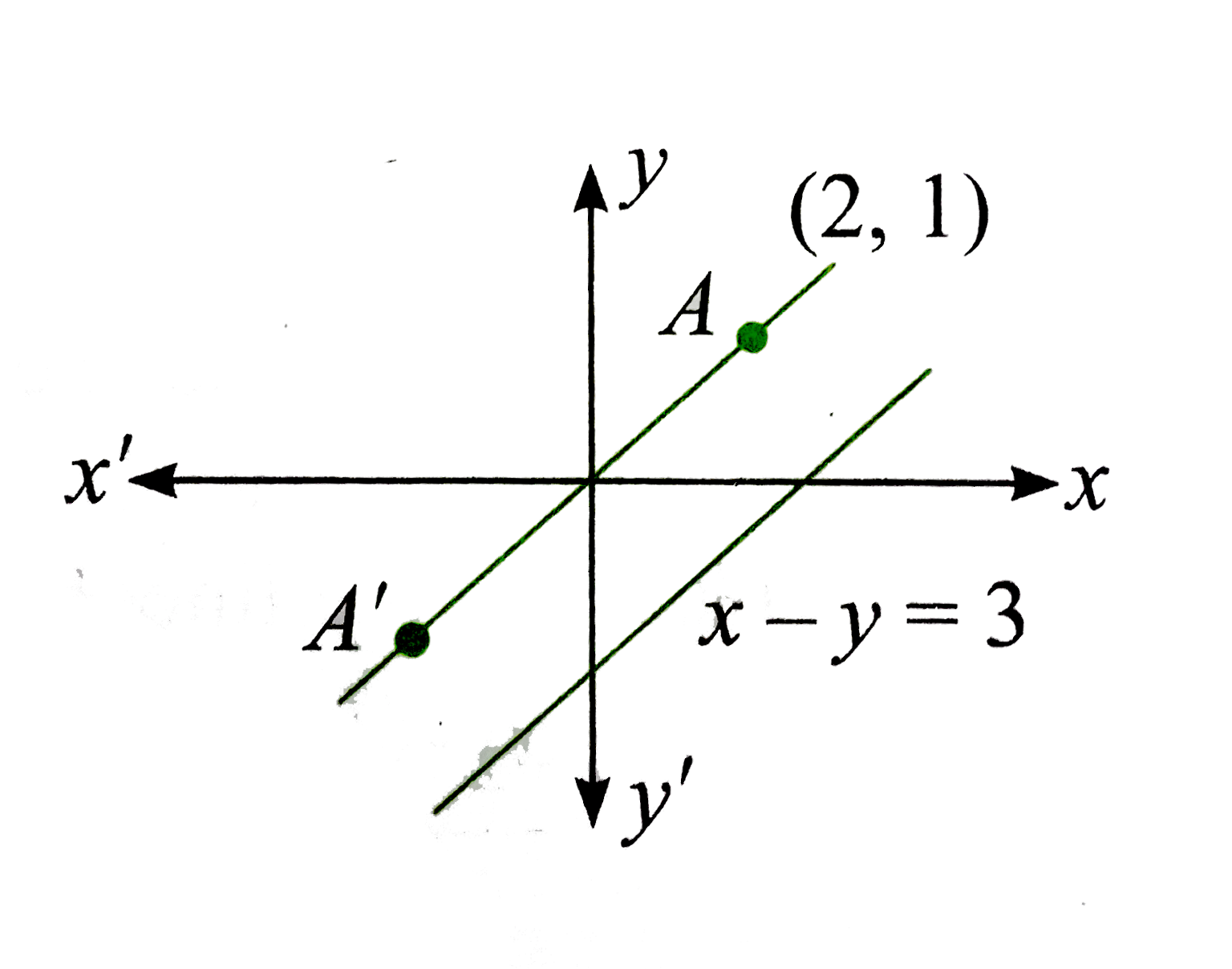The point A(2,1) is translated parallel to the line x−y=3 by a distance of 4 units. If the new position A' is in the third quadrant, then the coordinates of A' are (A) (2+2√2,1+2√2) (B) (−2+√2,−1−2√2) (C) (2−2√2 , 1−2√2) (D) none of theseSolution in Tamil
(2+2√2,1+2√2)
(−2+√2,−1−2√2)
(2−2√2,1−2√2)
none of these
The correct Answer is:C

Since the poinnt A(2,1) is translated parallel to x-y=3, A'A has the same slope as that of x-y=3. Therefore, A'A passes through (2,1) and has slope 1. Here, tanθ=1or cosθ=1√2,sinθ=1√2.
Thus, the equation of AA' is
x−2cos(π/4)=y−1sin(π/4)
Since AA' =4, the coordinates of A' are given by
x−2cos(π/4)=y−1sin(π/4)=−4
or x=2−4cosπ4,y=1−4sinπ4
or x=2−2√2,y=1−2√2
Hence, the coordinates of A' are (2−2√2,1−2√2).
Topper's Solved these Questions
- BOOK - CENGAGECHAPTER - STRAIGHT LINESEXERCISE - Exercise (Multiple)30videos
STRAIGHT LINES
- BOOK - CENGAGECHAPTER - STRAIGHT LINESEXERCISE - Exercise (Comprehension)27videos
STRAIGHT LINES
- BOOK - CENGAGECHAPTER - STRAIGHT LINESEXERCISE - Exercise 2.65videos
STRAIGHT LINES
- BOOK - CENGAGECHAPTER - STRAIGHT LINEEXERCISE - Multiple Correct Answers Type8videos
STRAIGHT LINE
- BOOK - CENGAGECHAPTER - THEORY OF EQUATIONSEXERCISE - JEE Advanced Previous Year9videos
THEORY OF EQUATIONS
Similar Questions
If P is a point (x,y) on the line y=−3x such that P and the point (3, 4) are on the opposite sides of the line 3x−4y=8, then x>815 (b) x>85 y<−85 (d) y<−815
02:28View SolutionLet L be the line belonging to the family of straight lines (a+2b) x+(a-3b)y+a-8b =0, a, b ∈R, which is the farthest from the point (2, 2).
Area enclosed by the line L and the coordinate axes is02:06View SolutionIf aandb are two arbitrary constants, then prove that the straight line (a−2b)x+(a+3b)y+3a+4b=0 will pass through a fixed point. Find that point.
07:24View SolutionThe point P(α,α+1) will lie inside the triangle whose vertices are A(0,3),B(−2,0) and C(6,1) if
01:25View SolutionQ. Let p and q real number such that p≠0,p2≠q and p2≠−q. if α and β are non-zero complex number satisfying α+β=−p and α3+β3=q, then a quadratic equation having αβ and βα as its roots is
04:07View SolutionThe value of ∣∣−1213+2√22+2√213−2√22−2√21∣∣ is equal to a. zero b. −16√2 c. −8√2 d. none of these
02:33View SolutionThe point A(2,1) is translated parallel to the line x−y=3 by a distance of 4 units. If the new position A' is in the third quadrant, then the coordinates of A' are (A) (2+2√2,1+2√2 (B) (−2+√2,−1−2√2) (C) (2−2√2 , 1−2√2) (D) none of these
02:14View SolutionIf a=(4sqrt(6))/(sqrt(2)+sqrt(3)) then the value of (a+2sqrt(2))/(a-2sqrt(2))+(a+2sqrt(3))/(a-2sqrt(3))
02:52View Solution1√9−√8 is equal to:
(a)3+2√2
(b) 13+2√2
(c) 3−2√2
(d) 32−√2
03:12View Solutionsin(6712)∘+cos(6712)∘ is equal to A) 12√4+2√2, B) 12√4−2√2, C) 14(√4+2√2), D) 14(√4−2√2)
03:20View SolutionThe value of ∣∣ ∣ ∣∣−1213+2√22+2√213−2√22−2√21∣∣ ∣ ∣∣ is equal to
02:29View SolutionFind the value of the determinant
∣∣ ∣ ∣∣−1213+2√22+2√213−2√22−2√21∣∣ ∣ ∣∣03:58View SolutionThe value of ∣∣−1213+2√22+2√213−2√22−2√21∣∣ is equal to a. zero b. −16√2 c. −8√2 d. none of these
08:11View SolutionThe point A(2,1) is translated parallel to the line x−y=3 by a distance of 4 units. If the new position A' is in the third quadrant, then the coordinates of A' are (A) (2+2√2,1+2√2 (B) (−2+√2,−1−2√2) (C) (2−2√2 , 1−2√2) (D) none of these
02:50View SolutionThe value of ∣∣ ∣ ∣∣−1213+2√22+2√213−2√22−2√21∣∣ ∣ ∣∣ is equal to
04:53View Solution1√9− √8 is equal to:
(a)3+2√2
(b) 13+2√2
(c) 3−2√2
(d) 32− √201:39View Solution

